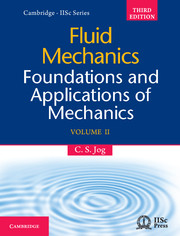Refine search
Actions for selected content:
8125 results in Fluid dynamics and solid mechanics
Contents
-
- Book:
- Fluid Dynamics
- Published online:
- 28 May 2018
- Print publication:
- 05 May 2015, pp vii-x
-
- Chapter
- Export citation

Fluid Mechanics
- Foundations and Applications of Mechanics
-
- Published online:
- 05 May 2015
- Print publication:
- 25 June 2015
16 - Complete Equations of Motion
-
- Book:
- Fluid Dynamics
- Published online:
- 28 May 2018
- Print publication:
- 05 May 2015, pp 147-159
-
- Chapter
- Export citation
APPENDIX A - Equations in Curvilinear Coordinates
-
- Book:
- Fluid Dynamics
- Published online:
- 28 May 2018
- Print publication:
- 05 May 2015, pp 239-241
-
- Chapter
- Export citation
A BIOLOGICAL TREATMENT OF INDUSTRIAL WASTEWATERS: CONTOIS KINETICS
- Part of
-
- Journal:
- The ANZIAM Journal / Volume 56 / Issue 4 / April 2015
- Published online by Cambridge University Press:
- 30 April 2015, pp. 397-415
-
- Article
-
- You have access
- Export citation
ANZ VOLUME 56 ISSUE 3 COVER AND FRONT MATTER
-
- Journal:
- The ANZIAM Journal / Volume 56 / Issue 3 / January 2015
- Published online by Cambridge University Press:
- 10 April 2015, pp. f1-f2
-
- Article
-
- You have access
- Export citation
ANZ VOLUME 56 ISSUE 3 COVER AND BACK MATTER
-
- Journal:
- The ANZIAM Journal / Volume 56 / Issue 3 / January 2015
- Published online by Cambridge University Press:
- 10 April 2015, pp. b1-b7
-
- Article
-
- You have access
- Export citation
A LOCALLY SMOOTHING METHOD FOR MATHEMATICAL PROGRAMS WITH COMPLEMENTARITY CONSTRAINTS
-
- Journal:
- The ANZIAM Journal / Volume 56 / Issue 3 / January 2015
- Published online by Cambridge University Press:
- 27 March 2015, pp. 299-315
-
- Article
-
- You have access
- Export citation
A NOTE ON THE STABILITY OF SWIRLING FLOWS WITH RADIUS-DEPENDENT DENSITY WITH RESPECT TO INFINITESIMAL AZIMUTHAL DISTURBANCES
-
- Journal:
- The ANZIAM Journal / Volume 56 / Issue 3 / January 2015
- Published online by Cambridge University Press:
- 26 March 2015, pp. 209-232
-
- Article
-
- You have access
- Export citation
10 - Simple Stress and Strain
-
- Book:
- Foundations and Applications of Engineering Mechanics
- Published online:
- 26 June 2025
- Print publication:
- 16 March 2015, pp 514-561
-
- Chapter
- Export citation
6 - Kinematics of Particle and Rigid Body
-
- Book:
- Foundations and Applications of Engineering Mechanics
- Published online:
- 26 June 2025
- Print publication:
- 16 March 2015, pp 340-398
-
- Chapter
- Export citation
11 - Bending and Shear Stresses in Beams
-
- Book:
- Foundations and Applications of Engineering Mechanics
- Published online:
- 26 June 2025
- Print publication:
- 16 March 2015, pp 562-600
-
- Chapter
- Export citation
Dedication
-
- Book:
- Foundations and Applications of Engineering Mechanics
- Published online:
- 26 June 2025
- Print publication:
- 16 March 2015, pp iii-iv
-
- Chapter
- Export citation
Index
-
- Book:
- Foundations and Applications of Engineering Mechanics
- Published online:
- 26 June 2025
- Print publication:
- 16 March 2015, pp 631-632
-
- Chapter
- Export citation
3 - Shear Force and Bending Moment
-
- Book:
- Foundations and Applications of Engineering Mechanics
- Published online:
- 26 June 2025
- Print publication:
- 16 March 2015, pp 144-206
-
- Chapter
- Export citation
9 - Mechanical Vibration
-
- Book:
- Foundations and Applications of Engineering Mechanics
- Published online:
- 26 June 2025
- Print publication:
- 16 March 2015, pp 485-513
-
- Chapter
- Export citation
OBLIQUE WAVE SCATTERING BY A RECTANGULAR SUBMARINE TRENCH
- Part of
-
- Journal:
- The ANZIAM Journal / Volume 56 / Issue 3 / January 2015
- Published online by Cambridge University Press:
- 16 March 2015, pp. 286-298
-
- Article
-
- You have access
- Export citation
Bibliography
-
- Book:
- Foundations and Applications of Engineering Mechanics
- Published online:
- 26 June 2025
- Print publication:
- 16 March 2015, pp 629-630
-
- Chapter
- Export citation
FOURTH-ORDER NUMERICAL METHODS FOR THE COUPLED KORTEWEG–DE VRIES EQUATIONS
- Part of
-
- Journal:
- The ANZIAM Journal / Volume 56 / Issue 3 / January 2015
- Published online by Cambridge University Press:
- 16 March 2015, pp. 275-285
-
- Article
-
- You have access
- Export citation
Contents
-
- Book:
- Foundations and Applications of Engineering Mechanics
- Published online:
- 26 June 2025
- Print publication:
- 16 March 2015, pp v-x
-
- Chapter
- Export citation

